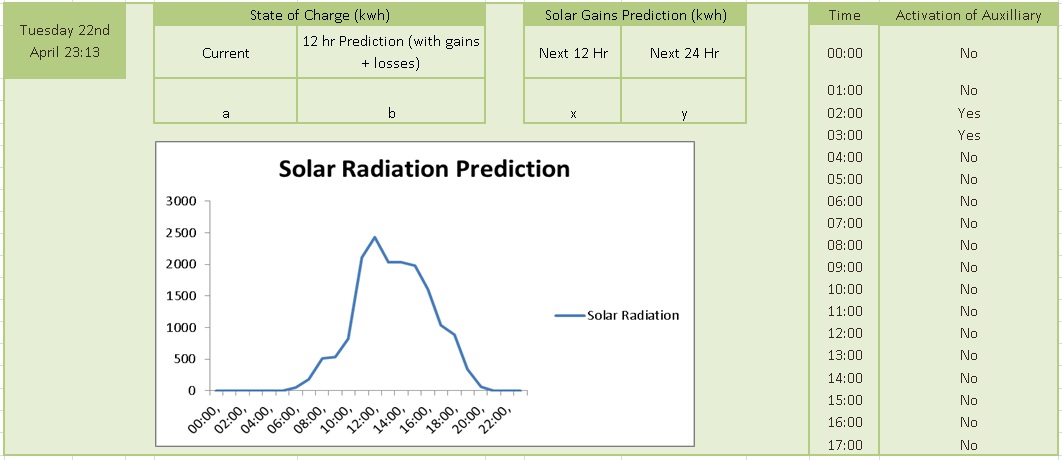-
Over 50% of the energy consumed in Scotland is used to heat and cool buildings and processes. (The Scottish Government,2014) Therefore this is obviously a key area where improvements can be made, in the form of both general energy reductions as well as trying to shift loads to more appropriate times. Well insulated water tanks can store large volumes of hot water and can effectively be used as an energy store to keep the hot water until it is needed.
There are renewable sources of energy such as solar or biomass that can be used to heat water in a domestic setting. Many of these systems will have back up electrical immersion heating for when renewable sources cannot meet demand. For these systems there is the potential for this demand for electricity to be shifted according to when there may be excess electricity available, this is possible due to the ability to store the hot water, as mentioned earlier. These thermal stores can be designed and controls implemented to prioritise solar thermal heat over other sources. This will mean that if solar heat is available, it will be used.
At Findhorn, we have investigated the heating systems employed at a group of buildings, the Centinis. These buildings have solar thermal heating systems with the option of back up electrical immersion heating. Depending on the amount of solar radiation incident, these systems will require varying amounts of electricity to provide the users heating requirements. The correct timing of the electrical backup alongside the ability to coast on preheated water gives opportunity for use of these systems to be varied and improved.
Objectives
- To model and simulate specific heating systems (similar to Centini systems) to investigate potential energy savings.
- Investigate hypothetical load shifting to see how this affects overall supply and demand match of community.
Outputs
- Highlight suitable areas for electrical load shifting in heating system.
- Produce ideas for improvement in heating systems control and how to possibly convey this to occupants.
- Contributing to overall quantification of deficit and surplus energy for the different energy system solutions proposed at Findhorn.
References
The Scottish Government. (2014) "Scotland’s Heat Map". Retrieved from The Scottish Government: http://www.scotland.gov.uk/Topics/Business-Industry/Energy/Energy-sources/19185/Heat/HeatMap
-
How can thermal storage be used for load shifting?
The Centini houses present load reduction and shifting opportunities because:
1) Presence of large storage tanks (500L)
2) Solar thermal technology incorporated
3) Electrical immersion backup
Energy Storage capacity varies depending on temperature that tank is heated to. We can see in the table below the different values calculated if the tank is heated to 80 or 60 degrees.
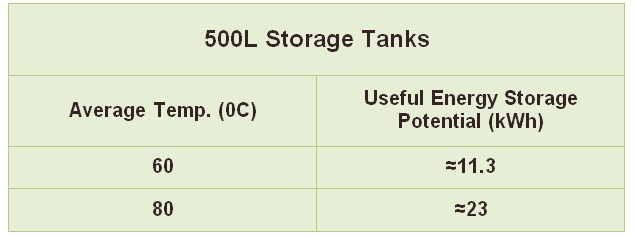
These tanks are fairly well insulated and we calculated from observing monitored data that they have approximate losses of 0.4°C per hour, but it is worth noting that this energy is dissipated as heat in house so cannot be viewed as completely “wasted” especially in winter! So with the large storage potential there is opportunity to pre-charge tank during night or excess wind generation and then “coast” on this energy, pre anticipating future demands for heating.
Pre-charging during the night is currently being done at some homes in Findhorn. The graph below is from monitored data and shows an example of pre-charging at one particular home in Findhorn.
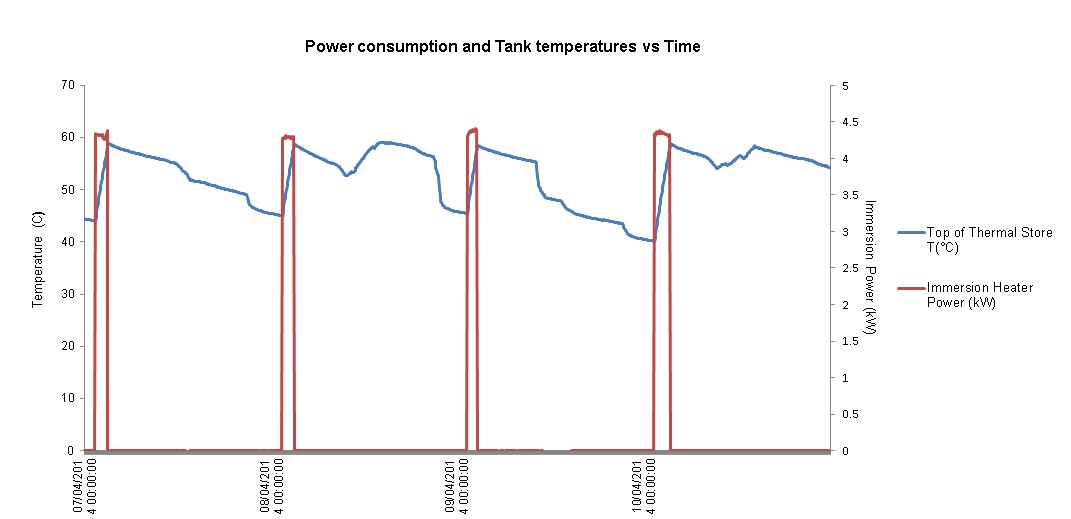
From graph we can observe:
1) Solar gain on certain days
2) Losses from tank
3) Regular significant electrical load (red line) which is shift-able
We can see here how this electrical load once a day is enough for heating and hot water requirements without further immersion heating. It is apparent that this load could be shifted, potentially within quite a large time window depending on demands (so you definitely do not want power this at peak times and preferably during periods of excess wind production!) The results and analysis for expansion of this behaviour is discussed in the generation and demand matching section.
The hypothetical load shifting that we proposed for matching analysis were as follows. There is also the potential option to try and coincide these heating loads with excess wind depending on wind profile predictions, and this is an area for further work.

-
How can electrical demands be reduced through controls?
Thermal stores can be effectively used with solar water heating systems as they allow solar thermal heat to be used for space heating as well as domestic hot water. With enough sun a solar thermal system can provide more heat than would be needed for domestic hot water and with a thermal store can this can also supply space heating. With control strategy a thermal store can also be designed to prioritise solar thermal heat above all other sources. This will mean that if solar heat is available, backup systems will not be used.
For our analysis of the thermal systems control aspect of our project we used a verified C# programme created by a student undertaking a previous project at Strathclyde University. (Sinclair, 2013) This programme modelled a system very similar to those present in the Centini buildings and calculates the amounts of energy used contributed by solar gains, and the amount by electrical back up. This is given as outputs of auxiliary energy use and a solar factor.
Where the solar factor is :

See below for examples of the programme display.
Base Application Form
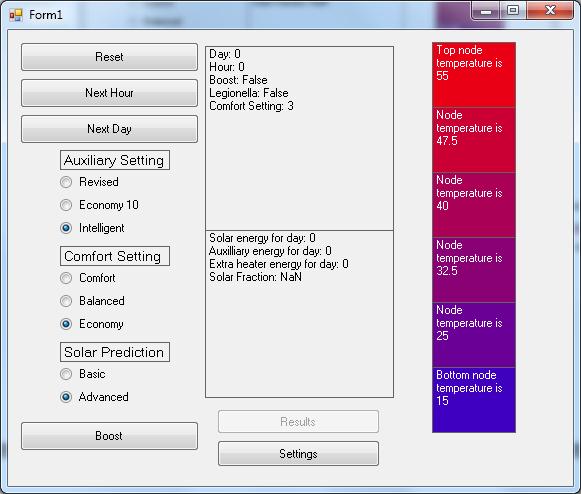
Standard Simulation Form (4 different day simulations)
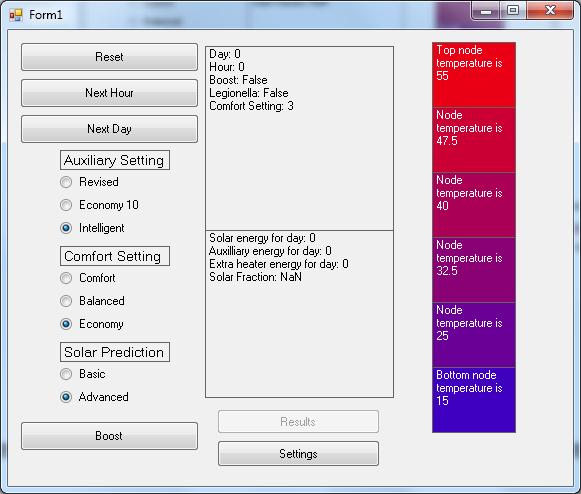
In this we select advanced solar predictions which have been pre-programmed to match 4 seasonal days using solar data obtained for Kinloss for last year (2013). The comfort settings required and auxiliary settings can also be altered to provide 3 control settings for the electric immersion back up.
Results Forms - Comparing two control settings
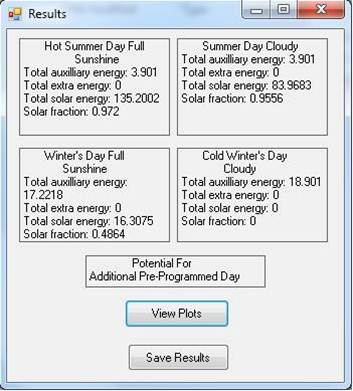
Here we can see an example of two results outputs with 4 different seasonal days that were pre-programmed using the solar data for each day (exact days and figures used in excel file and obtained from C# programming code).
Each day has a pre-programmed draw profile, and has been taken as a ‘worst case scenario’, i.e. for the Cold winter’s day cloudy the draw profile is significantly higher, with lots of hot water required in the morning for space heating and hot water needs and again in the late afternoon/early evening. With this the programme calculates the potential energy supplied from the solar thermal panels, using the solar data provided, and the required energy needed from the auxiliary immersion heater to meet heating demands. It can be seen that altering the control settings can increase the solar fraction - particularly for less sunny days.
Occupant behaviour has a large impact on energy usage and the effectiveness of systems and draw profiles are a key variable when modelling. Simulating realistic occupant behaviour is very complicated, because of variations and unpredictability in how households consume hot water and central heating systems. Even an individual household has highly variable behaviour on small timescales (daily) this means that there is a large random component involved. For our investigation we did not use specific draw profiles from Findhorn, using “typical” draw profiles meant our results could to be applicable on a wider scale.
References
Sinclair, M. (2013) "Improving the performance of Solar Hot Water and Backup Systems, EM401: Final Report". University of Strathclyde.
-
The potential of Demand Side Management
Occupant behaviour has a large impact on energy usage and the effectiveness of systems - draw profiles are a key variable when modelling. Because of this Demand Side Management is a very important aspect of matching supply and demand as well as overall energy reduction efforts.
For increased performance of systems, occupants can be very much involved in the running of their heating systems. Solar Thermal controls and various weather predictions can be communicated to user for increased control and management. This gives the user ability to make informed decisions regarding whether they want to pre charge their tanks and importantly when. So the above is the kind of information that could potentially be shown with a user interface, so on a predicted hot summers day, with user specific predicted demand behaviour, the user can see what energy they can get from the solar panels that day, and what energy is required from the immersion heater.
If immersion is obviously needed to meet predicted demands then users could then theoretically look at the wind forecast for that day, and with this information they can determine when is best to turn on the auxiliary heater. (Also option to consciously change demand profile!) Useful energy currently stored in tank (state of charge) could also be displayed, giving user information on whether they need auxiliary or not. If we pre-charge X homes Y amount, how will this affect overall demand and matching? An example of this is discussed in the generation and demand match analysis section. At Findhorn there is potential funding to financially reward occupants for contributing to overall matching. It will be interesting to how this motivates the community’s behaviour in the future!
Below is an example design of what such a user interface could display and communicate.
